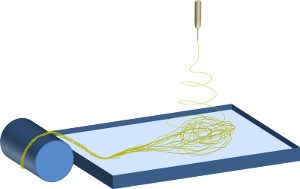▼ Reference
- Franco E, Dussán R, Amú M, Navia D. Statistical Optimization of the Sol-Gel Electrospinning Process Conditions for Preparation of Polyamide 6/66 Nanofiber Bundles. Nanoscale Research Letters 2018; 13: 230. Open Access
- Medina E F, Arjona S D, Corrales F Z, Borras V A. Morphological and mechanical response characterization of nanofiber aggregates of PVA produced by electrospinning sol-gel process. Dyna 2013; 178: 109. Open Access
- Pan Z J, Liu H B, Wan Q H. Morphology and Mechanical Property of Electrospun PA 6/66 Copolymer Filament Constructed of Nanofibers. 2008; 1: 47. Open Access
- Smit E, Buttner U, Sanderson R D (2005) Continuous yarns from electrospun fibers. Polymer 46 pp. 2419.
- Yao C, Li X, Song T. Preparation of zein/poly(lactide-co-glycolide) continuous nanofiber yarns by coupled electrospinning. 234th ACS National Meeting, Boston, MA, Aug 19-23, 2007.
▼ Credit and Acknowledgement
Author
Wee-Eong TEO View profile
Email: weeeong@yahoo.com
 ElectrospinTech
ElectrospinTech
